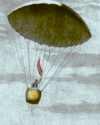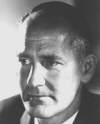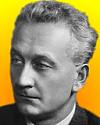
On 22 Oct 1797, the first parachute jump was made by André-Jacques Garnerin, released from a balloon 2,230-ft above the Parc Monceau, Paris. He rode in a gondola fixed to the lines of a 23-ft diameter parachute, which was supported by a wooden pole and had its 32 white canvas gores folded like a closed umbrella. Lacking any vent in the top of the parachute, Garnerin descended with violent oscillations, and suffered the first case of airsickness.
The article on Garnerin and Parachutes from Adventures in the Air: Being Memorable Experiences of Great Aeronauts (1877) gives the date of the jump as 18 Jun 1797, and from the Gardens of Tivoli. Since other sources give the date as 22 Oct, that is a discrepacy to be resolved. Still, the remainder of the narrative makes interesting reading about Garnerin.

On 22 Oct 1938, xerography was invented by Chester Carlson. Xerography was so unusual and nonintuitive that it was not until 1960 that his great persistence finally resulted in the introduction of the xerox office machine. The first plain-paper office copier prototype was built with parts scrounged from junkyards, cleaning brushes made of hand-sewn rabbit fur, and a built-in fire extinguisher. Today's book pick is: Copies in Seconds: How a Lone Inventor and an Unknown Company Created the Biggest Communication Breakthrough Since Gutenberg--Chester Carlson and the Birth of Xerox, by David Owen who reveals the persistence, courage, and imagination of an extraordinary group of physicists, engineers, and corporate executives.
It is available from Amazon, typically about New from $13.79. Used from $3.18. (As of earlier time of writing - subject to change.)
 | In a sense, genetics grew up as an orphan. In the beginning botanists and zoologists were often indifferent and sometimes hostile toward it. 'Genetics deals only with superficial characters', it was often said. Biochemists likewise paid it little heed in its early days. They, especially medical biochemists, knew of Garrod's inborn errors of metabolism and no doubt appreciated them in the biochemical sense and as diseases; but the biological world was inadequately prepared to appreciate fully the significance of his investigations and his thinking. Geneticists, it should be said, tended to be preoccupied mainly with the mechanisms by which genetic material is transmitted from one generation to, the next. |
 | Physical geography and geology are inseparable scientific twins. |
 | If any student comes to me and says he wants to be useful to mankind and go into research to alleviate human suffering, I advise him to go into charity instead. Research wants real egotists who seek their own pleasure and satisfaction, but find it in solving the puzzles of nature. |
| Before you look at today's web page, see if you can answer some of these questions about the events that happened on this day. Some of the names are very familiar. Others will likely stump you. Tickle your curiosity with these questions, then check your answers on today's web page. | |
| Births | |
 | Charles Glen King, born 22 Oct 1896, was a biochemist who in 1932 isolated a vitamin after five years of painstaking research extracting components from lemon juice. The vitamin is also known as ascorbic acid, (a- = not, without; scorbus = scurvy), Can you name this vitamin? |
| Deaths | |
 | Guillaume Le Gentil (1725-1792) was a French astronomer who attempted to observe a particular astronomical event by travelling to India in 1761. He failed to arrive in time due to an outbreak of war. He stayed in India to see the next occurrence of the event which came eight years later. This time, he was denied a view because of cloudy weather, and so returned to France. There, he found his heirs had assumed he was dead and taken his property. What event did he go to India to observe? |
| Events | |
 | On 22 Oct 1981, aspartame artificial sweetener was approved for tabletop use by the U.S. Food and Drug Administration. G.D. Searle marketed it as a low-calorie artificial sweetener without the bitter aftertaste of saccharin. By what tradename was aspartame marketed by G.D. Searle? |
 | On 22 Oct 1797, the first successful parachute jump was made by André-Jacques Garnerin, from a balloon 2,230-ft above Paris. He used a 23-ft diameter parachute, but Garnerin descended with violent oscillations, and suffered the first case of airsickness. What design feature was missing from his parachute that caused the oscillations during the descent? |
Fast answers for the previous newsletter for October 21: The decade including the year 1901 • cadavers • tunneling shield, the basic tool of underwater tunneling • Tennessee • Planck constant (h), the elementary charge (e), the Avogadro constant (NA), • 40 hours.
 If you enjoy this newsletter, the website, or wish to offer encouragement or ideas, please send feedback by using your mail reader Reply button.
If you enjoy this newsletter, the website, or wish to offer encouragement or ideas, please send feedback by using your mail reader Reply button. Your click on a Facebook, StumbleUpon, or other social button on the site webpages is also a welcome sign of appreciation. Thank you for using them.
© This newsletter is copyright 2020 by todayinsci.com. Please respect the Webmaster's wishes and do not put copies online of the Newsletter — or any Today in Science History webpage. (If you already have done so, please remove them. Thank you.) Offline use in education is encouraged such as a printout on a bulletin board, or projected for classroom viewing. Online, descriptive links to our pages are welcomed, as these will provide a reader with the most recent revisions, additions and/or corrections of a webpage. For any other copyright questions, please contact the Webmaster by using your mail reader Reply button.
--
If you do not want to receive any more newsletters, Unsubscribe
To update your preferences and to unsubscribe visit this link
Executive Real Estate Business Class
-
"It was like a man with wings. It wasn't like anything you'd see on TV or in a monster movie." ...
About the publisher
Search This Blog
Blog Archive
-
▼
2020
(1542)
-
▼
October
(171)
- The Compass: Iceland
- A Very Special Halloween Edition Of Our Scariest S...
- On This Day for October 31 - Luther's Ninety-five ...
- Newsletter for Saturday 31 October.
- CORONAVIRUS UPDATE: Why some people are supersprea...
- October 31: Martin Luther Challenges the Pope, Mic...
- PHOTOGRAPHY: Capturing America's pent-up energy to...
- The Terrifying Story Of The Mothman, The Little-Kn...
- The Roundup Top Ten from History News Network
- On This Day for October 30 - Henry Tudor crowned k...
- Newsletter for Friday 30 October.
- October 30: Tsar Nicholas II 'October Manifesto', ...
- ANIMALS: Will oil drilling spread across spectacul...
- On This Day for October 29 - Collapse of U.S. stoc...
- Newsletter for Thursday 29 October.
- October 29: End of China's One-Child Policy and Lo...
- YOUR WEEKLY ESCAPE: The science of the heebie-jeebies
- SCIENCE: Will every hurricane season be like this?
- The Latest News from History News Network
- On This Day for October 28 - Statue of Liberty ded...
- Newsletter for Wednesday 28 October.
- October 28: Fingerprints, Prohibition and the Blac...
- TRAVEL: When do Americans say they’ll fly again?
- Were vampire hunters real? Subscribe to find out.
- On This Day for October 27 - Anwar Sadat and Menac...
- Newsletter for Tuesday 27 October.
- October 27: China's Population Reaches 1 Billion a...
- HISTORY: Rush of early voters spurs talk of a record
- New This Week on History News Network
- On This Day for October 26 - Park Chung Hee assass...
- Newsletter for Monday 26 October.
- October 26: Beginning of the Red Cross and the Gun...
- FAMILY: When the best advice to your kids isn't yours
- On This Day for October 25 - English triumph at Ag...
- Newsletter for Sunday 25 October.
- October 25: The Great United Nations China Switch ...
- The Compass: Japan
- On This Day for October 24 - United Nations establ...
- Newsletter for Saturday 24 October.
- October 24: Two Great Historical Stock Market Crashes
- CORONAVIRUS UPDATE: How to fight the COVID-19 'inf...
- PHOTOGRAPHY: The best photojournalism of the decade
- What did Cleopatra look like? | Charles and Diana’...
- 11 Spooky Urban Legends Based On Terrifying True S...
- The Roundup Top Ten for October 23, 2020
- On This Day for October 23 - U.S. and French troop...
- Newsletter for Friday 23 October.
- October 23: US National Debt, an Old Fossil and th...
- ANIMALS: They were researching cheetahs. Iran call...
- Love the show Weird But True? Get more WBT with ev...
- Early Holiday Savings at the HISTORY Store
- Introducing the Britannica All New Kids' Encyclope...
- On This Day for October 22 - Cuban missile crisis,...
- Newsletter for Thursday 22 October.
- YOUR WEEKLY ESCAPE: These prehistoric footprints t...
- October 22: Greenwich Mean Time, the Cuban Missile...
- SCIENCE: Will the next generation fight a pandemic...
- On This Day for October 21 - Magellan's discovery ...
- The Latest News from History News Network
- October 21: Battle of Trafalgar, China Occupies Ti...
- TRAVEL: We found 50 stories in 50 states for ‘Amer...
- On This Day for October 20 - Opening of Sydney Ope...
- Newsletter for Tuesday 20 October.
- October 20: On This Day in History
- HISTORY: Why do we have the Electoral College?
- Join photographer Pete Muller for an online conver...
- New This Week on History News Network
- On This Day for October 19 - Surrender of Lord Cor...
- Newsletter for Monday 19 October.
- October 19: On This Day in History
- FAMILY: Letting kids take charge
- The lost heirs of Henry VIII
- On This Day for October 18 - Alaska Purchase appro...
- Newsletter for Sunday 18 October.
- October 18: French Protestants, The Alaska Purchas...
- The Compass: Portugal
- On This Day for October 17 - Mother Teresa awarded...
- Newsletter for Saturday 17 October.
- October 17: Burma Railway, OPEC Oil Embargo and Ra...
- CORONAVIRUS UPDATE: Who will be first in line for ...
- PHOTOGRAPHY: How COVID-19 changed our work
- The 25 Best Horror Movies Of All Time — And The Ch...
- This Week's Roundup Top Ten from History News Network
- On This Day for October 16 - Marie-Antoinette guil...
- Newsletter for Friday 16 October.
- October 16: Battle of Leipzig, Mao's Long March an...
- ANIMALS: The wildlife photo of the year
- Challenge grant: Help unlock important funds for w...
- On This Day for October 15 - Final conference on A...
- Newsletter for Thursday 15 October.
- October 15: Napoleon's Exile, the 1st Oral Contrac...
- YOUR WEEKLY ESCAPE: A murder mystery 430,000 years...
- SCIENCE: Will the next generation fight a pandemic...
- The Latest News on History News Network
- On This Day for October 14 - Battle of Hastings, D...
- Newsletter for Wednesday 14 October.
- Historic Trends in our time may be overcome with g...
- October 14: William the Conqueror, Robert the Bruc...
- The Embarrassing Final Moments Of 10 Revered Histo...
- TRAVEL: Does your wine taste like fire?
-
▼
October
(171)
-
Blogroll
-
About
HistoryFact










I liked your work and the way in which you have shared this article here about test and tag supplies .It is a beneficial and helpful article for us. Thanks for sharing an article like this .
ReplyDelete